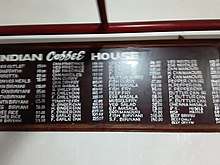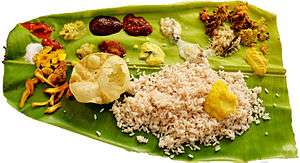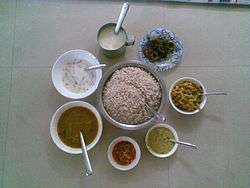Cuisine of Kerala
The cuisine of Kerala, a state in the south of India, is linked to its history, geography, demography and culture. Kerala cuisine offers a multitude of both vegetarian and non-vegetarian dishes prepared using fish, poultry and red meat with rice a typical accompaniment. Chillies, curry leaves, coconut, mustard seeds, turmeric, tamarind, and asafoetida are all frequently used.
Kerala is known as the "Land of Spices" because it traded spices with Europe as well as with many ancient civilizations with the oldest historical records of the Sumerians from 3000 BCE.[1][2]
Historical and cultural influences
In addition to historical diversity, cultural influences, particularly the large percentages of Muslims and Christians, have also contributed unique dishes and styles to Kerala cuisine, especially non-vegetarian dishes. The meat eating habits of the people were historically limited by religious taboos. Brahmins eschew non vegetarian items. However, most modern-day Hindus do not observe any dietary taboos, except a few of those belonging to upper castes who do not consume beef or pork.[3] Most Muslims do not eat pork and other items forbidden by Islamic law. Alcohol is available in Kerala in many hotels and over a thousand bars and liquor stores, but state authorities plan to close the vast majority of these outlets in a ten-year plan, beginning in 2014, to combat problem drinking.[4]
Overview

One of the traditional Kerala dishes is vegetarian and is called the Kerala Sadya, which is an elaborate banquet prepared for festivals and ceremonies. A full-course Sadya, which consists of rice with about twenty different accompaniments and desserts is the ceremonial meal of Kerala eaten usually on celebratory occasions including marriages, Onam and Vishu. It is served on a plantain leaf.
Because of its rich trading heritage, over time various indigenous Kerala dishes have been blended with foreign dishes to adapt them to local tastes. Coconuts grow in abundance in Kerala, so grated coconut and coconut milk are commonly used for thickening and flavouring.[5] Kerala's long coastline and numerous rivers have led to a strong fishing industry in the region, making seafood a common part of meals. Rice is grown in abundance along with tapioca. It is the main starch ingredient used in Kerala's food.[6]
Having been a major production area of spices for thousands of years, the region makes frequent use of black pepper, cardamom, clove, ginger, and cinnamon. Kerala also has a variety of breakfast dishes like idli, dosa, appam, idiyappam, puttu, and pathiri.[7]
Hindu cuisine
Many of Kerala's Hindus, except certain communities and ovo-lacto vegetarians, eat fish and chicken.[8] Some communities, on the other hand, are famed for their vegetarian cuisine consisting of milk and dairy-based dishes, especially various varieties of sambar and rasam. In most Kerala households, a typical meal consists of rice, fish, and vegetables. Beef, contrary to the outlook of the remaining Indian society, also plays a prominent role in Kerala cuisine. The meat is featured in Hindu, Christian and Islamic communities of Kerala.
Sadhya


Erachichor
Erachichor is a traditional meat-rice dish in Kerala cuisine. Erachichor is cooked in a mud pot, and steamed with a banana leaf covering.[9]
Cuisine of the Syrian Christians

Syrian Christians, or Mar Thoma Nasranis, of Kerala have their own cuisine. Particularly well-developed are the snacks and savouries of Syrian Christians such as "achappam" and "kuzhalappam". A favourite dish of Kerala Christians is "mappas", or chicken stew. For this dish, chicken, potatoes and onions are simmered gently in a creamy white sauce flavoured with black pepper, cinnamon, cloves, green chillies, lime juice, shallots and coconut milk.[10] Lamb and duck can replace chicken in the stew recipe.[10]
Other dishes include piralen (chicken stir-fries), meat thoran (dry curry with shredded coconut), sardine and duck curries, and meen molee (spicy stewed fish).[10] This is eaten with another dish known as appam. Appam, kallappam, or vellayappam are rice flour pancakes which have soft, thick white spongy centres and crisp, lace-like edges.[10] "Meen Mulakittathu" or "Meen vevichathu" (fish in fiery red chilly sauce) is another favourite item.[10]
"Pidi", a type of rice dumplings in thick gravy, is a famous Syrian Christian delicacy. "Pidi" is paired best with chicken curry.
In addition to chicken and fish, Syrian Christians along with a section of Hindus and all Muslims in Kerala eat red meat. "Irachi ularthiathu" is a beef dish cooked with spices.[10]
Muslim cuisine
Muslim cuisine or Mappila cuisine is a fascinating blend of traditional Kerala, Persian and Arab food culture. This amazing confluence of culinary cultures is best seen in the preparation of most dishes.
Biriyani (mutton, chicken, Beef, lamb or prawn) made as ‘dum’ tops the list of delicacies. Thalassery Biriyani the only version of biriyani in Kerala. Kallummakkaya (mussels) curry, erachi puttu (erachi means meat), parottas (soft flatbread), pathiris (a type of rice pancake) and ghee rice are some of the other specialties. The characteristic use of spices is the hallmark of Mappila cuisine. spices like black pepper, cardamom and clove are used profusely.
The snacks include unnakkaya (deep-fried, boiled ripe banana paste covering a mixture of cashew, raisins and sugar), pazham nirachathu (ripe banana filled with coconut grating, molasses or sugar), muttamala made of eggs, chattipathiri, a dessert made of flour, like baked, layered chappatis with rich filling, arikadukka and so on
References
- "Of Kerala Egypt and the Spice link". The Hindu. Thiruvananthapuram, India. 28 January 2014.
- Striving for sustainability, environmental stress and democratic initiatives in Kerala, p. 79; ISBN 81-8069-294-9, Srikumar Chattopadhyay, Richard W. Franke; Year: 2006.
- Social mobility in Kerala Kanjirathara Chandy Alexander
- Hughes, Tammy (22 August 2014). "730 bars to shut in alcohol ban". London Evening Standard. p. 25.
- Zero Oil South Indian Cook Book. Dr. Bimal Chhajer. ISBN 9788128805127.
- India, [report prepared by] Planning Commission, Government of (2008). Kerala development report. New Delhi: Academic Foundation. ISBN 8171885942.
- Bhandari Laveesh (2009). Indian States at a Glance 2008–09: Performance, Facts and Figures – Kerala. Pearson Education India. pp. 36–. ISBN 978-81-317-2340-1. Retrieved 26 June 2012.
- Chatterjee, editors: Ashok K. Dutt, H.N. Misra, Meera (2008). Explorations in applied geography (Eastern economy ed.). New Delhi: Asoke K. Ghosh, Prentice-Hall of India, Private Limited. ISBN 9788120333840.CS1 maint: extra text: authors list (link)
- "Erachi choru| Irachi choru recipe | Mathrubhumi Online". english.mathrubhumi.com. Retrieved 5 May 2019.
- Marks, Gil (2010), Encyclopedia of Jewish Food, John Wiley and sons
External links
| Wikimedia Commons has media related to Cuisine of Kerala. |